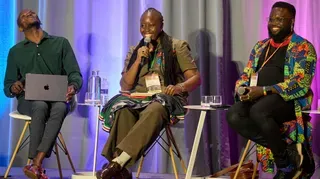September 29, 2011
Technology is Changing the Once-Simple Cookbook
Kilian Melloy READ TIME: 5 MIN.
With a box full of carrots and a hankering for something vaguely exotic, Mary-Claire van Leunen turned to her computer for a recipe.
"I looked for 'Turkish carrots' and I found it easily, in fact I found half a dozen," said the retired Seattle software researcher.
Everyone's done it, fired up a search engine to deal with that mound of parsley or a bumper crop of cucumbers. But van Leunen wasn't randomly appealing to the online universe. She was searching the recipes in her own cookbooks, the roughly 2,000 volumes that line her shelves. Without ever cracking a single spine.
"In the past, I would have gone to the Central Asian section of my books and gone through the indexes," says van Leunen. "I would have looked in two or three cookbooks, and wound up adapting something for fennel or something to the carrots."
Today, the online cookbook indexing service called Eat Your Books lets her instantly search the index of nearly every cookbook she owns. When she finds the recipe she wants, the website tells her the book it's in.
It's part of a new wave of digital tools that are changing the way home cooks explore new recipes, revisit old ones and create satisfying meals.
Eat Your Books, launched nine months ago, boasts a library of 88,000 books with more than 2,000 indexed volumes. Users just tell the site which cookbooks they own, then they can quickly peruse the recipes of the chefs and authors they already trust.
Likewise, the website Cookstr catalogues recipes from more than 500 chefs and cookbook authors and offers them to users - free of charge. And mobile applications and e-books, once little more than digitized versions of cookbook content, have begun adding features that make the experience interactive and highly personal.
"It is completely feasible today that a mobile device will be the center of the connected kitchen and Cookstr wants to be at the center of that connected kitchen," says Cookstr chief executive officer Art Chang.
Cookstr offers roughly 8,000 recipes from 16 major cookbook publishers, each of them sifted by a team of food-savvy "curators" who categorize them by variables such as ingredient, nutritional information, even taste and texture. Want a chicken dish that's spicy, requires only one pot and has fewer than 500 calories per serving? Cookstr offers up 16 recipes, including West African chicken stew and a Thai green curry.
The company has extended the reach of this highly personal, on-demand approach to actual cookbooks, packaging the well-known "1-2-3" series of three-ingredient cookbooks from award-winning author Rozanne Gold into 32 different digital books for iPhones and iPads. Sold through Apple's iBookstore, recipes can be purchased in bundles of 10, 50 or 250, allowing buyers to build their own a la carte recipe collections.
And cooks seem to be responding to these new digital options. Cookstr has grown from 12,000 users when it launched nearly three years ago to roughly 250,000 unique visitors a month, Chang says.
Meanwhile, anticipation of the digital dining revolution has prompted designers of applications or "apps" - the programs that run on mobile phones and tablets such as the iPad - to add features that go beyond simple ingredient searches and shopping list creation to elements such as "push" notices that send daily recipes to your device, "shuffle" functions that create new menus from the same tranche of recipes, ingredient substitution options and comprehensive videos on tips and techniques.
CulinApp, a Houston-based application development company, plans to offer products that couple cookbook content from well-known chefs and authors with high-definition video personalized to the individual user's preferences - cookbook meets on-demand cooking show.
The company's just-released first app combines two-dozen recipes from baking expert Dorie Greenspan's bestselling cookbook, "Baking: From My Home to Yours," with comprehensive video of every step in every recipe. Text can be viewed in four different formats, from traditional cookbook page to a flowchart of ingredients and steps. The video can be consumed whole or broken into individual parts, called "spin view," depending on what the user wants. When the user finishes making the recipe, a timer function keeps track of the baking time.
"There are a lot of people out there who are intimidated by baking," says Laurie Woodward, founder of the online community Tuesdays with Dorie, which has spent the last four years baking its way through the hardcopy of Greenspan's cookbook. "This is a really great way to introduce people to baking who are more visual."
If the new technologies are changing the way people cook, they're also changing the way authors write. Greenspan says the app allows her to offer tips and advice that she couldn't in a printed cookbook - for instance, demonstrating what "room temperature" butter looks like (it should hold a fingerprint). Greenspan says it also forced her to re-think her recipes and communicate them in a different way.
"If you beat the butter and sugar and eggs and flour, what do you call that in spin view?" she says. "It challenged me to do things that I never do, to dissect the recipe, reconstruct it and to keep in mind 'Will it make sense? Will it track?'"
But book lovers need not mourn the death of print just yet. Eat Your Books fan van Leunen says the site actually has inspired her to buy more books. And social media expert Natanya Anderson says the on-demand nature of sites like Cookstr will allow people to explore cuisines more efficiently and cost effectively than buying a whole cookbook.
But what does appear in print likely will change.
"In 10 years we'll find very specific kinds of things that are important to have in print, whether it's a glossy magazine for the holidays or gorgeous cookbooks that are memorable, and then this whole other class of content that's about getting dinner on the table," says Anderson, senior social media manager for Whole Foods Market Inc. and a veteran developer of online communities. "And I'm okay with that. If there's more cooking information available to more people at price points and in more formats that they can utilize, then that's a win for everybody."
Technology boosters say the new developments might get more people into the kitchen, and bring the people already there closer together. CulinApp's format includes tabs for Facebook and Twitter so users can instantly communicate what they're doing. Cookstr's Chang says the company is exploring increasing its social media presence. And van Leunen says she regularly peruses the bookshelves of other Eat Your Books members to find like-minded souls.
"There's a little back alley social networking going on," she says.
Kilian Melloy serves as EDGE Media Network's Associate Arts Editor and Staff Contributor. His professional memberships include the National Lesbian & Gay Journalists Association, the Boston Online Film Critics Association, The Gay and Lesbian Entertainment Critics Association, and the Boston Theater Critics Association's Elliot Norton Awards Committee.







